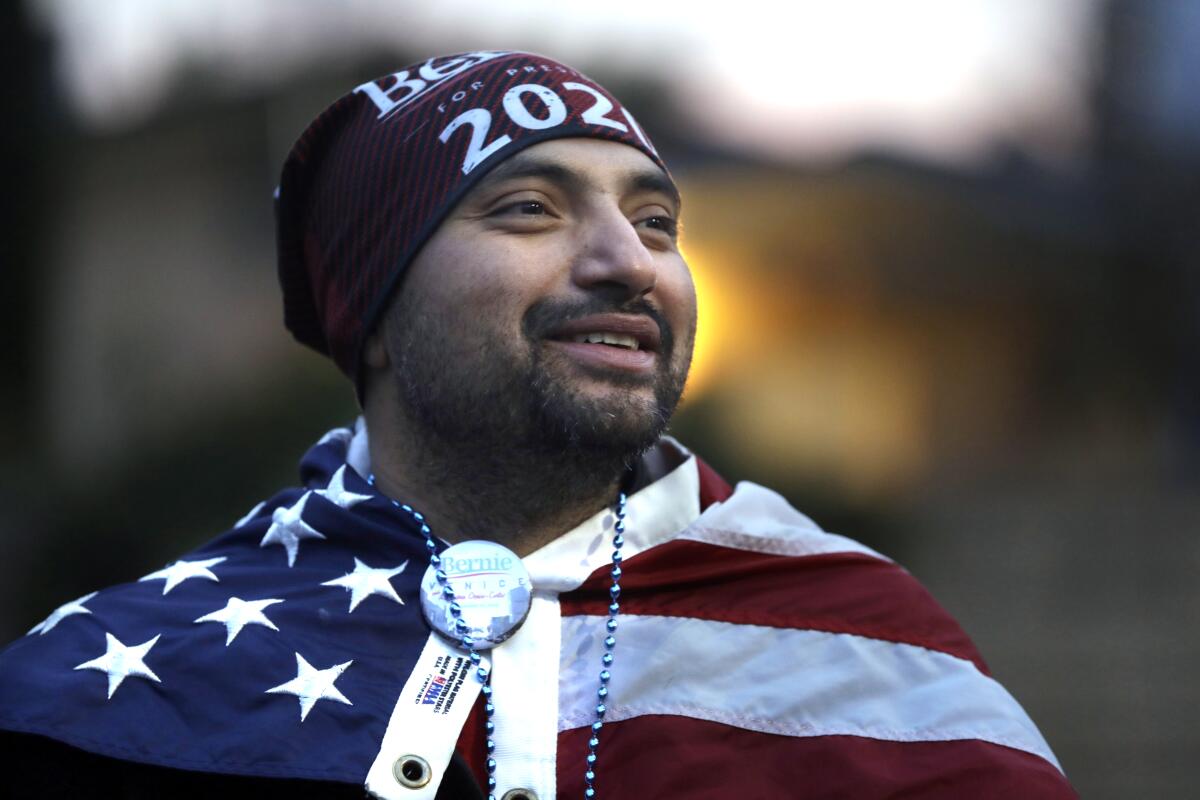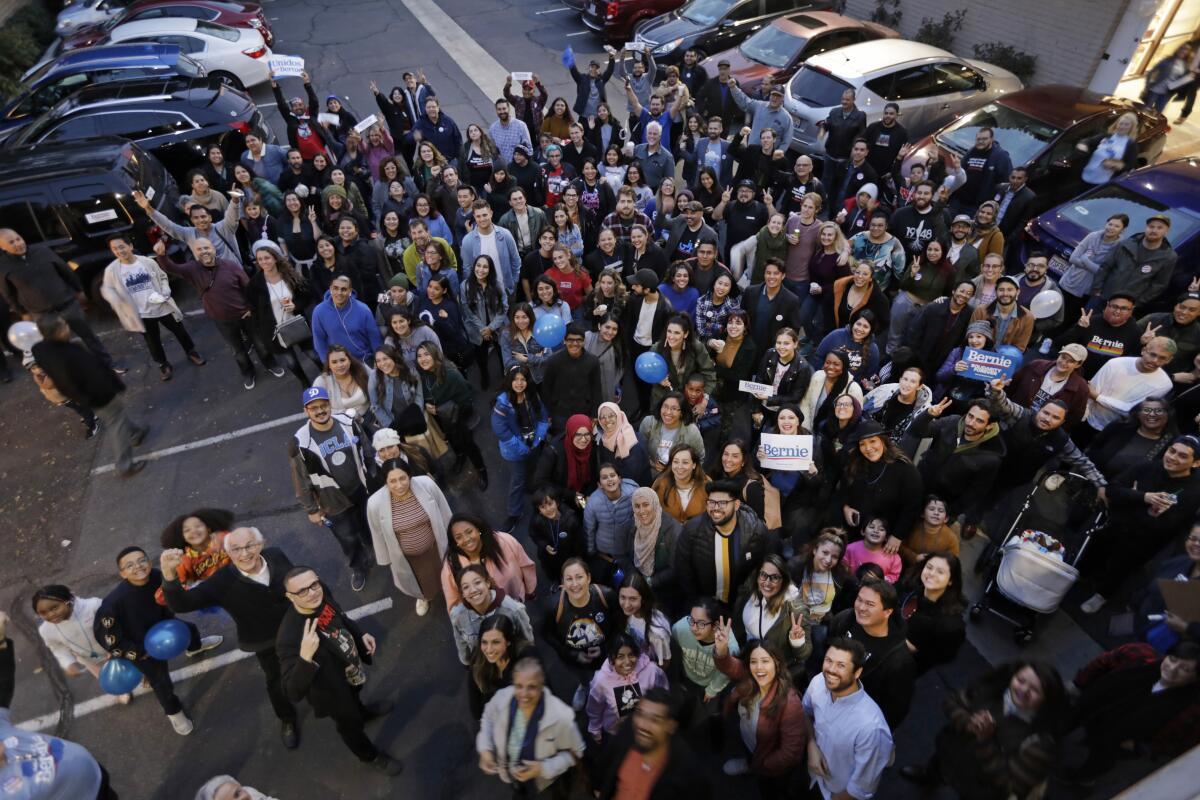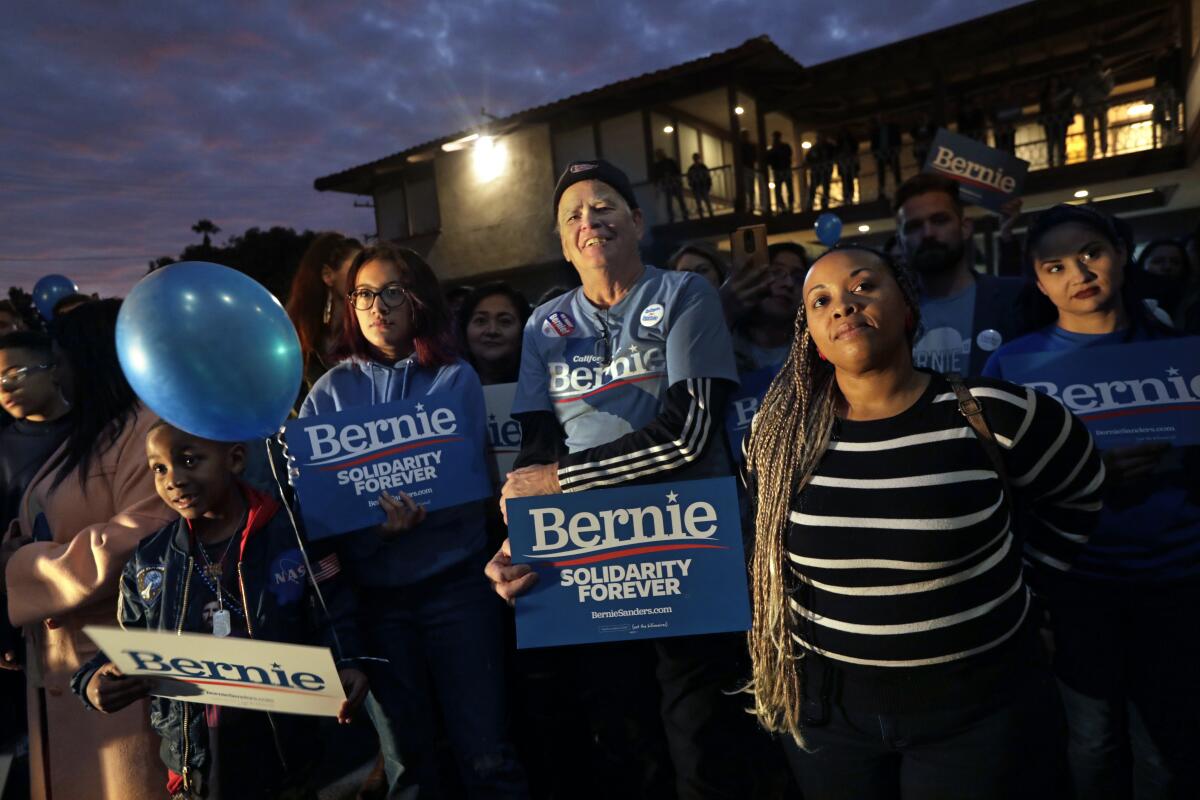In newly blue Orange County, Democrats struggle over how far left is too far

- Share via
Emma Jenson, standing in front of over 200 Bernie Sanders supporters gathered in the parking lot of a Santa Ana office park, asked for a show of hands to see who had knocked on doors for the 2016 election.
Few had.
“Notice that my hand didn’t go up,” the San Clemente resident said. “But things are different now. This is what democracy looks like.”
The ostensible reason for the recent Sunday evening rally was the opening of Sanders’ Orange County campaign office. But Jenson’s remarks about how Democratic people power can beat Republican might resonated with the crowd for reasons beyond their favored candidate.
It was like a family reunion for the Orange County left. College students who were in the U.S. illegally stood shoulder to shoulder alongside hijabis. Huntington Beach residents who fought against a garbage dump in their barrio chatted with Brea anti-racism activists. Most were people of color.
Along with liberal white activists, they had helped to do the once-unthinkable: turn Orange County — a longtime Republican citadel — blue. And push the historically moderate local Democratic Party to the left.

“I don’t think I’ve ever seen all of us together at the same time,” said Benjamin Vazquez, an ethnic studies teacher at Valley High School in Santa Ana. “Not even for May Day.”
Andy Lewandowski, who said he grew up in “the white privilege bubble” of Costa Mesa and Orange, marveled at the scene before him.
“It’s great,” said the 59-year-old, who wore an OC Women’s March T-shirt with a button that said “Unidos con Bernie” (“United with Bernie”). “Progressives are starting to work within the political system. It’s time.”
Ever since 2016, when Hillary Clinton became the first Democratic presidential candidate to carry the county since Franklin D. Roosevelt, academics and the news media have heavily covered Orange County’s political transformation. A clean sweep of the congressional districts in 2018, coupled with Democrats’ overtaking Republicans in registered voters last summer, has made the story even more compelling.
Pundits have attributed the shift to college-educated women, changing demographics, conservative dislike for President Trump and the urbanization of a county Ronald Reagan once described as “the place all the good Republicans go to die.”
The new, blue Orange County is a cause celebre among Democratic presidential candidates. Vermont Sen. Sanders has addressed cheering Disneyland Resort employees. Businessman Andrew Yang visited twice last year. Massachusetts Sen. Elizabeth Warren sent a recorded message to the O.C. Democrats’ annual awards dinner praising their gains. Minnesota Sen. Amy Klobuchar addressed a packed town hall in August, later tweeting: “Now I know how you turned the tide from red to blue…. Keep it up!”
Lesser known is the ongoing fight between progressive and moderate Democrats in Orange County for the party’s soul.
To outsiders, the rift is befuddling. After decades in the political wilderness, why risk the Orange County Democrats’ historic wins?
But the divide between moderates (generally wealthier, older and white) and progressives (younger, forged in the social justice battles of the last decade and Latino-led) is real. And it mirrors the debate across the U.S. among Democrats about whether a more centrist or more leftist candidate has the best chance to defeat Trump in 2020.

“There’s always going to be people who want to start desmadre [raise hell],” said Claudio Gallegos, district director for Rep. Lou Correa (D-Santa Ana), who has long weathered attacks from within his own party for a middle-of-the-road approach. “The old guard needs to realize that change is coming. This isn’t your grandpa’s Orange County, and we need to bring [progressives] in. But to progressives, I say beware of tribalism. They seem to stick to their own clique and freeze out people who may have potential, but because they started under moderate politicians, they cut them off. That helps no one.”
“It’s true that we’re in Orange County, and that we’ve got to be careful,” said Ada Briceño, co-president of Unite Here Local 11 and chair of the Democratic Party of Orange County. “I’m the chair for everyone. But we’ve got to bring one person at a time around to believe in collective activism and change.”
The Nicaraguan immigrant is part of that change. Two weeks after becoming party chair last January, Briceño was arrested along with other protesters for blocking an intersection in Anaheim in support of higher wages for hotel workers. And her union nearly forced the cancellation of the Dec. 19 Democratic presidential debate at Loyola Marymount University over a labor dispute.
Briceño said that during the recent California Democratic Party state convention in Long Beach, delegates and politicians from across the state wanted to know how to bottle her party’s newfound pixie dust.
“People are looking to what we’ve been doing here long-term,” she said. “It’s been impressive to see that we matter.”
Randall Avila, executive director of the Republican Party of Orange County, said local Democrats “are not doing themselves any favors” by focusing on “virtue-signaling” issues, arguing that residents care more about day-to-day things like traffic and housing.
“We’re going to take it to the voters and show them how far left they’re going,” he said. “Orange County has always been the gold standard for Republicans, and [Democrats] capturing that crown jewel got them too excited to reshape it completely.”
Despite its conservative stereotype, one born from decades-long reality, Orange County has seen a long, lively history of progressive — even radical — activism.
Mexican, Jamaican and Japanese fieldworkers staged strikes back when the county was an agricultural powerhouse. Latino plaintiffs won some of the earliest court cases in the U.S. against housing covenants and school segregation in the 1940s; the Black Panthers established a chapter in Santa Ana during the 1960s.
But in the last decade, a rainbow’s worth of causes — homelessness, police brutality, Disneyland workers, “sanctuary” cities, LGBTQ rights, even the Ku Klux Klan — brought out a new generation of grass-roots organizers with numbers and stridency never before seen locally.
They publicly confronted Democratic luminaries like former Rep. Loretta Sanchez and longtime Santa Ana Mayor Miguel Pulido over their supposed centrist sins — in Sanchez’s case, not speaking out more loudly about undocumented college students, while getting after Pulido for aligning himself too closely with developers who have gentrified Santa Ana.
A 2014 American Civil Liberties Union lawsuit that brought district elections to Anaheim pushed Fullerton, Costa Mesa, San Juan Capistrano, Orange and Garden Grove to follow and inspired more rabble-rousing novices to run for office.
Joesé Hernandez, a Sanders co-regional director for Orange County alongside Jenson, found his political awakening in the Occupy movement and eventually helped in campaigns for affordable housing and voter turnout in Anaheim and Santa Ana. He said progressives tended to “hit a brick wall” when confronted with the reality that their actions frequently proved moot against unsympathetic politicians.
In the last few years, though, “it’s been quite a markup of individuals coming out of the shadows [to] run as progressives, unashamed and unabashed,” the 35-year-old said. “That was once not even in the realm of possibilities.”
More recently, activists have criticized trade unions — a crucial part of the Democratic fundraising and get-out-the-vote efforts — over their support of construction projects like a desalination plant and hotels that activists say exacerbate environmental and cost-of-living problems.
Briceño has faced criticism from the party’s moderate flank but also from the left. In October, the Orange County Democratic Party Central Committee passed a resolution that asks the federal government to “reform” Immigration and Customs Enforcement instead of “abolish” the agency, as the resolution originally stated. As a result, Lewandowski and other Sanders supporters plan to run for Central Committee seats.
Meanwhile, Briceño is undeterred by criticism that people like her are moving the party in Orange County too left too fast. She pointed out that Democrats outpaced Republicans in voter registration by 15,000 voters since this summer — an unimaginable margin just a few years ago.
“People are really fearful that if we push too little or too much, we’ll lose what we’ve won,” she said. “But we overcome fear by having a really strong plan.”
More to Read
Sign up for Essential California
The most important California stories and recommendations in your inbox every morning.
You may occasionally receive promotional content from the Los Angeles Times.











